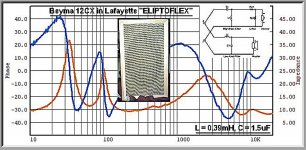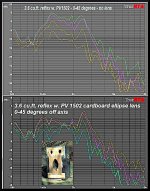for those not familiar, here's the 1953 R-J article.
Pg 1 https://i.imgur.com/USGxSSe.jpg
Pg 2 https://i.imgur.com/nDVeDqg.jpg
Pg 3 https://i.imgur.com/nEtRkU9.jpg
Pg 1 https://i.imgur.com/USGxSSe.jpg
Pg 2 https://i.imgur.com/nDVeDqg.jpg
Pg 3 https://i.imgur.com/nEtRkU9.jpg
I’ve made an RJ like XKi where the vent looks like a Karlson aperture but diamond shaped. Box vent tuning follows XKi methodology. The aperture adds the typical Karson response with some dips in midrange and an earlier falloff at high frequency. Maybe I should try the lemon shape? What’s the typical aperture area vs front cross section area for RJ?
you might be able to estimate it pretty well from this picture of my RJ12 cabinet. I assume the round hole is around 10.25 in diameter as was made to rear mount 12" speakers.
I'll have to check the baffle spacing but may have been 3/4" cleats - there's not enough "chamber" in an RJ to screw up response

Here's an Eliptoflex (which didn't truncate its aperture vs Sd) vs a 1954 Karlson K12 outdoors. That B102 - K12 combo made a tragic graph
I would assume the JBL lens with RJ venting would make a nice speaker with enhanced horizontal polars

JBL style lens

another way might be like one of my old 18" boxes which had RJ venting
- the K-type cut might be extended a bit higher/lower
my friend built one with a circular opening and remarked mine sounded better.
This design was published in an early 1950's issue of Audio Engineering magazine
- the builder de-Q-ed the cabinet by drilling many holes through the front and sub-baffle
- he used asbestos board . . . .

I'll have to check the baffle spacing but may have been 3/4" cleats - there's not enough "chamber" in an RJ to screw up response

Here's an Eliptoflex (which didn't truncate its aperture vs Sd) vs a 1954 Karlson K12 outdoors. That B102 - K12 combo made a tragic graph
I would assume the JBL lens with RJ venting would make a nice speaker with enhanced horizontal polars

JBL style lens

another way might be like one of my old 18" boxes which had RJ venting
- the K-type cut might be extended a bit higher/lower
my friend built one with a circular opening and remarked mine sounded better.
This design was published in an early 1950's issue of Audio Engineering magazine
- the builder de-Q-ed the cabinet by drilling many holes through the front and sub-baffle
- he used asbestos board . . . .

Last edited:
it would be interesting for test RJ type to have a screw-on aeprture plate to allow comparisons of various apertures. My only issue with the original little RJ which held a 15" was the use of too thin wood. 18mm or 15mm well braced Baltic birch would be better. It was truly a tiny cabinet and mine doesn't "boom" with EV SP15
speakers like some of the Nirvana with hot -rising on-axis response could play well in RJ type
here's that EV 15" fullrange speaker - it has a "control" - can't remember if I graphed its action
ELECTRO VOICE EV SP15 15" Speaker - $159.00 | PicClick
speakers like some of the Nirvana with hot -rising on-axis response could play well in RJ type
here's that EV 15" fullrange speaker - it has a "control" - can't remember if I graphed its action
ELECTRO VOICE EV SP15 15" Speaker - $159.00 | PicClick
Is the RJ enclosure an aperiodic tuning? Somewhere between aperiodic and bass reflex?
Are there any studies on the aperture shape and size and the effect on sound and dispersion?
I shall drop this here as being relevant, the BBC's slotted baffle LS5/5.
https://www.grahamaudio.co.uk/technology/slotted-baffles/

Are there any studies on the aperture shape and size and the effect on sound and dispersion?
I shall drop this here as being relevant, the BBC's slotted baffle LS5/5.
https://www.grahamaudio.co.uk/technology/slotted-baffles/
Technically seems to be a quasi series 6th order BP (BP6S). The aperture shape can add some damping similar to using the click test to critically damp a reflex and depending on the driver/app maybe a good plan for the RJ too: Click Test:
Cool - nice to see a continuation of "BBC slot" application.
An R-J type might be made ~ "aperiodic" but don't think the originals with ~3/4" sub- baffle spacing behaved quite that way.
My impedance pplot for an RJ must be in an old pc or lost.
Here's input Z for Lafayette Radio's "Eliptoflex" which is an RJ with a non resstriictive opening
An R-J type might be made ~ "aperiodic" but don't think the originals with ~3/4" sub- baffle spacing behaved quite that way.
My impedance pplot for an RJ must be in an old pc or lost.
Here's input Z for Lafayette Radio's "Eliptoflex" which is an RJ with a non resstriictive opening
Attachments
Seems like the slot would have to be quite small to come anywhere near aperiodic without some sort of damping/stuffing.
Here are the BBC reports of both the RJ speaker and the LS5/5. I think it's the other way around - the LS5/5 came after the RJ with lessons learned.
http://downloads.bbc.co.uk/rd/pubs/reports/1955-08.pdfhttp://downloads.bbc.co.uk/rd/pubs/reports/1967-57.pdf
Where is the documentation on the JBL woofer lens thing?
http://downloads.bbc.co.uk/rd/pubs/reports/1955-08.pdfhttp://downloads.bbc.co.uk/rd/pubs/reports/1967-57.pdf
Where is the documentation on the JBL woofer lens thing?
I hadn't yet read but ASR appears to have a discussion
https://www.audiosciencereview.com/...l-woofer-directivity-control-waveguide.12133/
https://www.audiosciencereview.com/...l-woofer-directivity-control-waveguide.12133/
I think the ellipse is counterproductive here, it's too circular to have much useful effect on dispersion. A slot works better because the edges can get closer to the center and it is irregular enough to not have a lot of standing waves. The JBL diffraction slot works because the irregular shape reduces the potential for standing waves even further.
And apparently when you treat it as a diffraction slot, there is a relationship between beam width, frequency and slot width.
1000000/angle/frequency = slot width in inches
From what I can tell, in the BBC LS5/5 the slots are only used to increase the dispersion a bit before crossover. There is probably a rule of thumb about how many degrees you can change the dispersion without getting standing waves.
In the Spendor BCIII, the woofer has a slight slot, almost as if to almost bring the woofer width down to the width of the mid. In the BBC report of the LS5/5 they compare a 110mm driver with a 200mm driver in a 110mm slot.
And apparently when you treat it as a diffraction slot, there is a relationship between beam width, frequency and slot width.
1000000/angle/frequency = slot width in inches
From what I can tell, in the BBC LS5/5 the slots are only used to increase the dispersion a bit before crossover. There is probably a rule of thumb about how many degrees you can change the dispersion without getting standing waves.
In the Spendor BCIII, the woofer has a slight slot, almost as if to almost bring the woofer width down to the width of the mid. In the BBC report of the LS5/5 they compare a 110mm driver with a 200mm driver in a 110mm slot.
I believe you mean 10^6/(deg*Hz) 😉, so for baffle thick slots it's 180 deg and the baffle size/shape + any boundary loading sets dispersion angle (polar response).
Technically seems to be a quasi series 6th order BP (BP6S).
Indeed, I do look at it as a less extreme Karlson. I only ever kludged one up in foamcore (before it became a 'thing' 😉 ) for FF125K and don't remember much about it.
I'm surprised no has done a design where all parallel surfaces are canted/sloped at > ~12 deg (included) angle to in theory near enough remove all the pass band 'ripple' same as for removing 'slap echo' in rooms.
Do you mean for the RJ or Karlson?I'm surprised no has done a design where all parallel surfaces are canted/sloped at > ~12 deg (included) angle to in theory near enough remove all the pass band 'ripple' same as for removing 'slap echo' in rooms.
How about for the Klam? I don't know how effective it would be, but I roughly sketched a "Klam-horn" some years ago, where the Klam's front chamber has ~conical expansion as well as the longitudinal K-slot. The intent was more to eliminate parallel surfaces than to have horn-action thrown into the mix.
- Home
- Loudspeakers
- Full Range
- Nice page with R-J experiment


